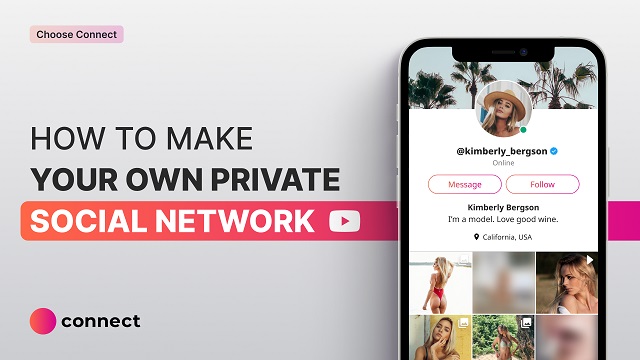Social media isn’t slowing down—it’s multiplying in influence, reach, and revenue. What started as a place to post photos and status updates has become a core infrastructure for communication, commerce, entertainment, and learning. From micro-communities to influencer-led businesses, the demand for specialized social platforms keeps expanding.
According to Spherical Insights, the global social media market size is projected to exceed $815 billion by 2033, with a compound annual growth rate of 14% between 2023 and 2033. At the same time, Statista reports that global social media users are expected to reach 6 billion by 2028—nearly three-quarters of the planet’s population.
That scale brings opportunity. If you’re exploring how to make a social media app, now is the time to get serious. This article will walk you through the key decisions, features, and development options required to turn a big idea into a successful social platform in 2026.
Identifying Your Niche and Target Audience

If you’re serious about learning how to make a social media app, the first step isn’t writing code—it’s figuring out who you’re building it for. With thousands of platforms already crowding app stores, the only way to stand out in 2026 is to build with purpose and specificity.
Generic platforms trying to appeal to everyone often end up serving no one particularly well. Instead, the most successful newcomers focus on a niche. That could be a community of LGBTQ+ users looking for safe, inclusive spaces. It could be designed for influencers and creators who want more control over how they engage and monetize their audience. Or maybe it’s aimed at hobbyists—gamers, gardeners, collectors—who want platforms built around their shared interests rather than algorithm-driven feeds.
Some examples of strong niche directions in 2026 include:
- LGBTQ+ communities looking for moderated, safe social spaces
- Influencers and creators wanting direct-to-audience control with monetization
- Professional consultants needing private messaging, scheduling, and video tools
- Fitness and wellness groups who want event-based and content-sharing features
- Hobbyists forming communities around shared passions like books, fashion, or gaming
Even professionals are carving out their own platforms in fields like coaching, nutrition, and finance. These users need tools that blend social interaction with content hosting, event scheduling, or private messaging. Understanding exactly what your audience needs—and what annoys them about mainstream platforms—will help you shape the right features from day one.
When you create your own social media platform, you’re not just building an app. You’re giving a community a home.
Exploring Different Types of Social Media Apps

Before diving into development, it’s important to understand what type of platform you’re aiming to build. If you’re wondering how to build a social media app in 2026, you first need to decide what kind of experience you’re creating—because “social media” now covers a wide range of formats, audiences, and goals.
Here are some of the most common categories:
1. Social Networks
These are platforms aimed at connecting individuals according to established relationships. Think Facebook or its miniature copies. They typically include elements such as timelines, friend requests, comments, likes, and individual profiles. Despite competition, social networks remain the ones to beat for general-purpose connecting, particularly among users 35 and older.
2. Content Sharing and Streaming Apps
Instagram, TikTok, and YouTube fall into this category. These platforms are built around media—photos, videos, reels—and often include live streaming, filters, or monetization tools for creators. If your audience includes influencers or visual storytellers, this is the format to consider.
3. Messaging Apps
WhatsApp, Telegram, and Signal are leading examples. These apps prioritize fast, secure, and private communication, often through end-to-end encryption. In 2026, many niche communities are adopting messaging-first platforms with added features like group channels, audio spaces, and integrated content sharing.
4. Professional Networks
LinkedIn used to have a monopoly on this space, but now it no longer has. Coaches, freelancers, and industry-specific professionals are all making the change to niche spaces that provide them with the space to network, collaborate, and even host events or sessions. This segment contains high growth opportunities for B2B apps.
5. Community-Based Apps and Forums
Reddit is the most well-known here, but dozens of smaller apps are thriving by hosting conversations around specific topics. These platforms encourage discussion, user-generated content, and sometimes anonymity—features that appeal to niche communities, hobbyists, and even support groups.
Each of these formats responds to different user needs—and in many cases, successful new platforms blend elements of two or more categories. For example, a fitness app might combine messaging, content sharing, and forums.
If you’re planning how to build a social media app, identifying the right category—or mix of categories—is one of the most important strategic decisions you’ll make. It defines your core features, monetization model, and the type of user experience you’ll be designing from day one.
Designing an Intuitive and Engaging User Interface

When considering how to create a social media app, it’s simple to become enamored of features and functionality. But no matter how strong the tool is, it will fail if users find it difficult or frustrating to use. That’s where UI/UX design enters the picture.
Design isn’t just about how your app looks—it’s also about how it feels. Your beautifully designed interface should guide users smoothly from one action to the next. Whether they’re posting content, joining a group, or updating their profile, the process should feel seamless. This is especially crucial in 2026 when users expect apps that are responsive, smooth, and mobile-first.
Some important guidelines for creating a social media app are:
- Clarity and simplicity: Prioritize clean layouts, readable fonts, and logical navigation.
- Responsiveness: Your app should function smoothly across devices and screen sizes, especially mobile.
- Accessibility: Include features like scalable fonts, color contrast, and screen reader compatibility to make your app inclusive.
- Consistent visual language: Use coherent branding, colors, and iconography across the app to establish trust and polish.
Usability testing is also a necessity. It’s not enough to design on assumptions—real users will always uncover friction points. Test early and often, with heatmaps, session recordings, or one-on-one interviews to observe how people actually use your interface.
Following on from user feedback means that your app develops with your users, not just with your team’s creativity. Having this loop as part of your design process prevents huge issues later on and makes your users feel heard and valued.
Ultimately, how to create a social media app that people love starts with empathy. Design with your user in mind, and they’re far more likely to stick around.
Choosing the Right Technology Stack

Once you’ve mapped out your features and design, it’s time to tackle the tech. Choosing the right technology stack is one of the most critical decisions you’ll make when planning to create social media app architecture that’s both reliable and scalable.
On the front end, you’ll need a framework that supports speed, responsiveness, and great user experience. React Native and Flutter are both popular cross-platform options—they let you build for iOS and Android from a single codebase. If your app will rely on complex animations or deep device integration, you might want to look into native development with Swift (for iOS) and Kotlin (for Android). Native applications tend to perform better but take longer (and more money) to build.
Back-end technologies handle everything that users don’t see—user accounts, data storage, chat logic, content feeds, etc. Node.js, Django (Python), and Ruby on Rails are all suitable choices here. When it comes to databases, MongoDB and PostgreSQL are both popular in social media app development because they are flexible and highly performing in databases.
But apart from functionality, you also need to look at long-term scalability. Your infrastructure has to support thousands—or even millions—of users down the line. That is why developers typically depend on cloud platforms like AWS, Google Cloud, or Firebase, which offer auto-scaling, robust APIs, and easy integrations.
Security is another key point. You’ll be managing user data, private messages, and possibly payment info. Encryption, secure authentication (OAuth 2.0), and compliance with regulations like GDPR should all be part of the initial architecture—not an afterthought.
The technology you choose will set the pace for your app’s performance, development speed, and flexibility for years to come. When you create social media app features that scale with user growth, you set the stage for real, long-term success.
Monetization Models That Work in 2026
If you’re thinking about how to create a social media app, revenue shouldn’t be an afterthought. With user habits evolving and ad fatigue setting in, successful platforms in 2026 are finding smarter, more user-friendly ways to make money. Here are five proven monetization strategies that go beyond traditional advertising:
- Subscriptions – Offer members exclusive content, early access to features, or a completely ad-free experience. Monthly or yearly plans provide consistent income and keep your business predictable.
- Freemium + In-App Upgrades – Enable users to utilize the basic platform free of charge but achieve additional advantages through one-time fees or tiered upgrades. Freemium is an effective model for any app type, ranging from professional networks to entertainment apps.
- Tipping & Donations – Allow users to directly support creators or community leaders. This builds loyalty and encourages content that actually serves the audience.
- Paid Groups & Private Rooms – Create walled-off areas for intense discussion, premium livestreams, or expert Q&A. These are great for business networks, coaching rooms, or intense interests.
- Marketplace Integration – Build in tools for users to buy and sell digital goods, offer online courses, or distribute downloadable content. This turns your platform into more than just a place to connect—it becomes a real economy.
When planning how to monetize your app, the best approach is a mix that aligns with your audience’s behavior. Choose what adds value without creating friction—and you’ll be set for growth.
Development Approaches: In-House vs. Outsourcing
When figuring out how do you make a social media app, one of the first logistical decisions you’ll face is who’s going to build it. You’ve got two main routes: hiring an in-house team or outsourcing development.
An internal team gives you direct control. You can sit with designers and developers, keep goals more closely aligned, and iterate quickly. It can be the ideal solution for startups with technical co-founders or companies with long-term development needs. But it is also costlier—hiring, salaries, equipment, and management all add up so fast. And finding the right talent (and holding onto it) takes time.
Outsourcing, on the other hand, can get your project up and running faster—especially if you use a team that already has experience on social media sites. You gain access to experienced developers, project managers, and UI/UX experts without needing to build an entire internal team. It’s generally cheaper in the short run and is especially appealing for those firms looking to pilot their concept without committing to a full build.
This is where Scrile Connect becomes an attractive option. It’s not just another off-the-shelf product—it’s a custom development service designed specifically for creating platforms like social networks, video-based communities, and creator marketplaces. For entrepreneurs who want flexibility, speed, and professional execution without hiring in-house, it provides a solid balance.
So, how do you make a social media app without overextending your resources? You choose the development path that aligns with your budget, timeline, and long-term goals.
Scrile Connect: Your Partner in Custom Social Media App Development

When it comes to figuring out how to make a social media app that truly stands out in 2026, off-the-shelf platforms and DIY builders often fall short. They limit your flexibility, restrict your brand identity, and rarely scale well. That’s where Scrile Connect steps in—not as a one-size-fits-all product, but as a fully customizable development service designed to bring your unique idea to life.
Scrile Connect isn’t just about building functional code. It’s about developing platforms that reflect your vision, business goals, and user expectations. Whether you’re launching a niche community app, a creator-focused network, or a new kind of content-sharing hub, Scrile Connect is designed to adapt to your needs.
Here’s what sets them apart:
- Customizable Features – You’re not locked into a template. From feed algorithms and chat systems to monetization tools and UI, everything can be tailored to your model.
- Scalable Architecture – Whether you’re launching with 100 users or planning for 1 million, the platform’s infrastructure is built to grow without sacrificing performance.
- Robust Security – With GDPR compliance, user data encryption, and fraud detection tools, your app is protected from the start.
- Ongoing Support – Development doesn’t end at launch. Scrile Connect offers continuous technical support, updates, and improvements to keep your app ahead of the curve.
Real-world case studies back it up. For example, one client partnered with Scrile Connect to create a video-based expert marketplace. With fully integrated payments, live consultations, and user subscriptions, the platform scaled to thousands of users in less than a year—all without compromising stability or user experience.
If you’ve been asking yourself how to make a social media app that’s more than a clone of what already exists, Scrile Connect may be exactly what you’re looking for. You bring the vision. They’ll bring the tech, the team, and the long-term support to help you build something exceptional.
Conclusion: Build With Purpose, Scale With Confidence
Understanding how to make a social media app goes far beyond development. It’s about building something people want to return to—something engaging, scalable, and worth sharing. The right UI, monetization strategy, and infrastructure can make or break your project.
In case you’re serious about taking your concept and transforming it into a winning platform, don’t go solo. Working with experts can spare you from costly mistakes and get you there faster.
Contact Scrile Connect team now—your vision, backed by their expertise. It’s the smartest move if you’re ready to how to create social media app that lasts.

Polina Yan is a Technical Writer and Product Marketing Manager, specializing in helping creators launch personalized content monetization platforms. With over five years of experience writing and promoting content, Polina covers topics such as content monetization, social media strategies, digital marketing, and online business in adult industry. Her work empowers online entrepreneurs and creators to navigate the digital world with confidence and achieve their goals.

